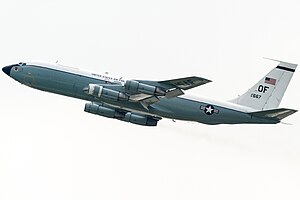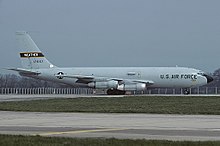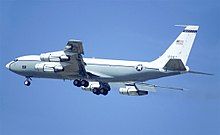Boeing WC-135 Constant Phoenix
| WC-135 Constant Phoenix | |
|---|---|

| |
| A WC-135 Constant Phoenix on takeoff | |
| Role | Atmosphere testing related to nuclear incidents |
| Manufacturer | BoeingMilitary Airplanes Division |
| Introduction | December 1965 |
| Status | 3 aircraft in service (WC-135R)[1] |
| Primary user | United States Air Force |
| Number built | 14 (10 converted C-135B, one converted EC-135C, three converted KC-135R) |
| Developed from | C-135 Stratolifter |
| Variants | OC-135B Open Skies |
TheWC-135 Constant Phoenixis a special-purpose aircraft derived from theBoeing C-135 Stratolifterand used by theUnited States Air Force.Its mission is to collect samples from theatmospherefor the purpose of detecting and identifyingnuclear explosions.It is also informally referred to as the "weather bird"[2]or "the sniffer" by workers on the program and international media respectively.[3]
Operational history[edit]


The WC-135 was introduced in December 1965, replacingBoeing WB-50aircraft in the weather-reconnaissance and air-sampling mission.[4]Ten aircraft were initially converted from C-135B transport aircraft and were placed in service with the55th Weather Reconnaissance SquadronatMcClellan Air Force Base,California,with theMilitary Airlift Command(MAC). Detachments were located at various bases throughout the United States and worldwide. Initially, the aircraft performed both weather reconnaissance and atmospheric sampling missions; however, in February 1974, the Air Force ordered that after 1 July 1974, WC-135s be used for atmospheric sampling missions only, thus ending the aircraft's weather reconnaissance mission.[5]The aircraft occasionally took on other roles throughout their careers; several aircraft were temporarily assigned to the 10th Airborne Command and Control Squadron atRAF Mildenhallin the late 1980s and early 1990s as training aircraft so that the unit could slow the accumulation of flight hours on itsEC-135Hs,[6]while others served as staff transports on an as-needed basis.
Upon retirement from frontline weather reconnaissance service in the early 1990s, five were retained for further use. Serial no. 61-2666 was converted to an NC-135 and remains in service as a testbed for RC-135 equipment upgrades. Serial no. 61-2667 was upgraded to a WC-135W, given the project nameConstant Phoenix,and remains in service with the45th Reconnaissance SquadronatOffutt Air Force Base,Nebraska.Serial no. 61-2674 was converted to the firstOC-135B Open Skiesobservation aircraft, reentering service in 1993. It was later stored in 1997 and replaced with two additional aircraft also converted from WC-135s.[7]
In 1998, a former EC-135C, serial no. 62-3582, was converted into a WC-135C, also designated Constant Phoenix.
In April 2018 it was announced that three KC-135R tanker aircraft would be converted as WC-135R Constant Phoenix aircraft to replace the two aircraft operated by the 45th Reconnaissance Squadron. The first aircraft was scheduled to be converted by L3 Technologies at Greenville, Texas starting in September 2019.[8]
In November 2020, WC-135C, tail number 62-3582, was retired during a ceremony at Offutt Air Force Base, Nebraska. During its 56 year career, it amassed 29,680 flight hours and 72,251 landings.[9]During its retirement ceremony, the 55th Wing chaplain dubbed the aircraft "Lucifer's Chariot", although the aircraft was never referred to by that name during its operational life.[10]
In June 2022, the first of three planned WC-135R aircraft (serial number 64-14836) completed its maiden test flight, and was delivered to the55th Wingon 11 July 2022.[11][12]The other two were delivered in May 2023 (tail number 64-14831)[13]and December 2023 (tail number 64-14829)[1]
Mission[edit]
TheWC-135B,WC-135W,andWC-135RConstant Phoenix atmospheric-collection aircraft support national-level intelligence consumers by collecting particulate debris and gaseous effluents from accessible regions of the atmosphere in support of theLimited Nuclear Test Ban Treatyof 1963. The information collected by the aircraft is utilized by Detachment 1 of theAir Force Technical Applications Center's21st Surveillance Squadron.[1]
Features[edit]
The Constant Phoenix's modifications are primarily related to the aircraft's on-board atmospheric collection suite, which allows the mission crew to detect radioactive debris "clouds" in real time. The aircraft is equipped with external flow-through devices to collect particulates on filter paper and a compressor system for whole air samples collected in high-pressure holding spheres. Despite the different designations, both the C- and W-models carry the same mission equipment (with a front-end avionics suite similar to the RC-135V and W aircraft). In addition to its collection systems, the WC-135 is equipped with a variety of aircrew safety systems which detect ambient air inside the cabin to detect radiation which may have contaminated the inside of the cabin. The cabin also contains two sets of air filtration systems, known as the "lungs", which filter all air entering the cabin of any hazardous contaminants. The WC-135R uses an improved next-generation collection suite as compared to the WC-135C/W, however the primary system functions are generally similar.
The interior seats 33 people, including the cockpit crew, maintenance personnel, and special equipment operators from theAir Force Technical Applications Center.On operational sorties, the crew is minimized to just pilots, navigator, and special-equipment operators, to reduce radiation exposure to mission-essential personnel only.
Variants[edit]
- WC-135B - 10 initial aircraft, converted fromC-135Bs
- WC-135C - Converted from former Looking Glass EC-135C Tail Number 62-3582, carries the same equipment as WC-135W
- WC-135R - 3 convertedKC-135Rs,announced in 2018 and included on the FY19 budget request.[8][14]The first converted aircraft, Tail Number 64-14836, was delivered in July 2022.[15][16]
- WC-135W - Re-designation of WC-135B Tail Number 61-2667 after upgrades and removal of flight engineer crew position in the 1990s.
Operators[edit]
Specifications[edit]
General characteristics
- Crew:4 flight crew + mission crew
- Length:139 ft 11 in (42.65 m)
- Wingspan:130 ft 10 in (39.88 m)
- Height:42 ft (13 m)
- Wing area:2,433 sq ft (226.0 m2)
- Airfoil:root:BAC 310/311/312;tip:BAC 313[18]
- Max takeoff weight:300,500 lb (136,305 kg)
- Powerplant:4 ×Pratt & Whitney TF33-P-9(WC-135C) /Pratt & Whitney TF33-P-5(WC-135W)turbofanengines, 16,050 lbf (71.4 kN) thrust each
Performance
- Maximum speed:403 mph (649 km/h, 350 kn)
- Range:4,000 mi (6,400 km, 3,500 nmi)
- Service ceiling:40,000 ft (12,000 m)
- Wing loading:123.5 lb/sq ft (603 kg/m2)
- Thrust/weight:0.21
Activities[edit]
Vela Incident[edit]
WC-135B aircraft flew 25 sorties in 1979 to try to ascertain whether adouble flashin the South Atlantic that was detected by aVela satellitewas a nuclear weapons test;[19]however, the result was inconclusive.
North Korea[edit]
On October 6, 2006, Japan'sKyodo Newsagency reported that a US military aircraft, equipped to detect radiation from a nuclear test, took off from southern Japan. This was believed to be part of US efforts to prepare to monitor a North Korean nuclear test. On October 9, 2006, North Korea's officialKorean Central News Agency(KCNA) reported that the country had performed a successful underground nuclear test. On October 13, 2006,CNNreported: "The U.S. Air Force flew a WC-135 Constant Phoenix atmospheric collection aircraft on Tuesday to collect air samples from the region. A preliminary analysis of air samples from North Korea shows 'radioactive debris consistent with a North Korea nuclear test', according to a statement from the office of the top U.S. intelligence official. The statement, from the office ofDirector of National IntelligenceJohn Negroponte,was sent toCapitol Hillbut not released publicly. CNN obtained it from a congressional source. The national intelligence office statement said the air samples were collected Wednesday, and analysis found debris that would be consistent with a nuclear test 'in the vicinity of Punggye' on Monday. TheSouth Korean Defense Ministrytold CNN that the United States has informed it that radioactivity has been detected. "The aircraft was based at Offutt AFB and was sent toKadena Air Baseon Okinawa to operate during the sampling missions.[20]
On June 17, 2009,JoongAng Dailyreported, in reference to a purported May 25 nuclear test by North Korea: "The U.S. Air Force twice dispatched a special reconnaissance jet, the WC-135 Constant Phoenix from Kadena Air Base in Okinawa, Japan, to collect air samples."[21]
On November 23, 2010,Sankei Shimbunreported that a WC-135 had been moved to Kadena Air Base in September 2010, in anticipation of a North Korean nuclear test.[22]
On January 31, 2013, the WC-135W was reported to be conducting surveillance flights out of Kadena Air Base in anticipation of another North Korean nuclear test.[23]
On January 6, 2016, the United States Air Force confirmed plans to soon deploy the WC-135 to test for radiation near North Korea to examine North Korea's claim that they had successfully conducted ahydrogen-bomb teston January 5 (EST).[24]
On September 8, 2016, it was reported that the WC-135 would soon begin surveillance flights near the Korean Peninsula[25]after South Korean officials confirmed that North Korea conducted itsfifth nuclear testat approximately 0:30 UTC.[26]
On April 12, 2017, it was deployed to Okinawa amid rising tensions with North Korea. North Korea conducted a missile test on April 3, 2017.[27]
On May 19, 2017, two Chinese Su-30 fighter jets intercepted a WC-135 over the East China Sea, prompting a formal complaint from the Pentagon.[28]
Japan[edit]
On March 17, 2011, CNN reported that the WC-135W had been deployed from Offutt AFB toEielson Air Force Basein Alaska. From there it assisted in detecting radioactive materials in the atmosphere around Japan, monitoring radioactivity released from theFukushima I Nuclear Power Plantcaused by themagnitude 9.0 earthquake and subsequent tsunamiof March 11, 2011.[29][30][31]
Europe[edit]
In 1986, multiple WC-135Bs were deployed to Europe to help monitor the air after theChernobyl disaster.[32][33]
On February 17, 2017, it was reported that the WC-135C had been deployed to RAF Mildenhall. It was conjectured that this came in response to several reports of anomalous levels ofiodine-131coming from the Norwegian-Russian Border, but as of April 10, 2017, there was no official cause of the iodine-131 release.[34][35][36]
In late July and early August 2021 a WC-135W deployed to Europe and carried out measurements over the Baltic Sea and Sweden. A connection is suspected with the technical problems of the RussianOscar-II-class submarineOrel,which subsequently had to be tugged back.[37]
See also[edit]
Related development
Aircraft of comparable role, configuration, and era
Related lists
References[edit]
- ^abc"Third, final WC-135R Constant Phoenix arrives".55th Wing Official Website.December 14, 2023.RetrievedDecember 21,2023.
- ^Cenciotti, David (April 12, 2017)."U.S. Air Force deploys WC-135" nuclear sniffer "plane to Japan to monitor North Korea's possible nuke weapons tests".
- ^Johnson, Jesse (May 20, 2017)."China denies intercept of 'nuke-sniffer' plane was unsafe, says U.S. must halt surveillance flights".The Japan Times.
- ^Harper, John."WC-135 Constant Phoenix".
- ^Colman, George N., Air Force Weather, Our Heritage 1937-2012, An Illustrated Chronology, 1 July 2012, Pg 5-10.
- ^"Aviation Photo #0179969: Boeing WC-135B (717-158) - USA - Air Force".Airliners.net.
- ^Hopkins III, Robert S. (2017).The Boeing KC-135 Stratotanker; More Than a Tanker.Crecy Publishing Limited. p. 289.ISBN978-1-91080-901-3.
- ^abAir Force Times "Air Force to start transforming tankers into WC-135" nuke sniffers "in FY19" dated April 26, 2018
- ^Liewer, Steve (November 16, 2020)."55th Wing retires cranky plane — dubbed 'Lucifer's Chariot' — in Offutt ceremony".Omaha World Herald.RetrievedNovember 17,2020.
- ^Roza, David (December 8, 2020)."'You are the reason I drink' — Airmen bid adieu to decrepit aircraft dubbed 'Lucifer's Chariot'".Task and Purpose.RetrievedSeptember 29,2022.[permanent dead link]
- ^HELFRICH, EMMA (June 30, 2022)."Air Force's First 'New' Constant Phoenix Nuke-Sniffing Jet Has Flown".The Drive Warzone.RetrievedJuly 4,2022.
- ^"Team Offutt welcomes first WC-135R to its fleet".July 12, 2022.RetrievedJuly 12,2022.
- ^"Second WC-135R arrives at Offutt".May 12, 2023.RetrievedDecember 21,2023.
- ^Trevithick, Joseph (February 14, 2018)."The US Air Force Wants a Trio of More Modern WC-135R Nuke Sniffing Planes".The Drive.RetrievedJuly 1,2022.
- ^Helfrich, Emma (June 30, 2022)."Air Force's First 'New' Constant Phoenix Nuke-Sniffing Jet Has Flown".The Drive.RetrievedJuly 1,2022.
- ^"Team Offutt welcomed a new aircraft to its fleet for the first time in decades when WC-135R Constant Phoenix tail number 14836 arrived at @lnk_airport today. This is the first of three WC-135R deliveries to the 55th Wing as the @usairforce is modifying three KC-135R Stratotankers to replace the aging aircraft. Originally delivered to the AF in 1964 and most recently flown by the New Hampshire Air National Guard, the new WC-135R was modified by Big Safari and will serve as the Air Force's newest atmospheric collection aircraft supporting national and international partners. Operated by the 45th Reconnaissance Squadron with support from Detachment 1, AF Technical Applications Center, it collects particulate and gaseous effluents and debris from accessible regions of the atmosphere in support of the Limited Nuclear Test Ban Treaty of 1963".Instagram.RetrievedJuly 12,2022.
- ^Pike, John."55th Wing [55th WG]".
- ^Lednicer, David."The Incomplete Guide to Airfoil Usage".m-selig.ae.illinois.edu.RetrievedApril 16,2019.
- ^"History of the Air Force Technical Applications Centre, Patrick Airforce Base, Florida: Volume 1"(PDF).United States AirforceviaNational Security Archive.May 4, 2006.RetrievedAugust 25,2008.
- ^Timesonline.co.uk,Cold War aircraft searches the sky for proof of test.
- ^joongangdaily.joins,U.S. finds that North test in May was nuclear.
- ^"U.S. Moves Spy Aircraft in Preparation for N.Korean Nuke Test".The Chosun Ilbo (English Edition).November 24, 2010.RetrievedJanuary 8,2016.
- ^Park Hyun and Jeong Nam-ku (January 31, 2013)."Clinton still hoping North Korea won't conduct a nuclear test".The Hankyoreh.RetrievedFebruary 13,2013.
- ^Lamothe, Dan (January 6, 2016)."This is the Air Force radiation sniffer plane deploying after North Korea's nuclear test".Washington Post.RetrievedJanuary 8,2016.
- ^Lendon, Brad (September 9, 2016)."US to fly 'radiation sniffer' jet off Korea".CNN.
- ^Katie Hunt; K. J. Kwon; Jason Hanna (September 9, 2016)."North Korea claims successful test of nuclear warhead".CNN.
- ^"Nuke-sniffer aircraft arrives on Okinawa as tensions rise on Korean peninsula".Stars and Stripes.RetrievedApril 12,2017.
- ^"Chinese fighter flies inverted over US Air Force jet".CNN.RetrievedMay 19,2017.
- ^"Japan quake tsunamiThis Just In".CNN.March 16, 2011. Archived fromthe originalon March 18, 2022.RetrievedMarch 17,2011.
- ^"Cosmic Log - U.S. boosts radiation-sniffing system".March 19, 2011. Archived fromthe originalon March 19, 2011.
- ^"FOIA – 2011-0118/0119/012"(PDF).Nuclear Regulatory Commission.January 26, 2012.
- ^"Constant Phoenix: After Decades of Service, a Little Recognition at Last".
- ^"WC-135 Constant Phoenix > U.S. Air Force > Fact Sheet Display".af.mil.RetrievedApril 18,2017.
- ^"U.S. Air Force deploys WC-135 nuclear sniffer aircraft to UK as spike of radioactive Iodine levels is detected in Europe".The Aviationist.February 19, 2017.RetrievedApril 12,2017.
- ^Bertrand, Pierre (February 23, 2017)."Europe baffled by" recent release "of radioactive Iodine-131".euronews.RetrievedApril 12,2017.
- ^Rogoway, Tyler (February 19, 2017)."Has There Been A" Nuclear Incident "In The Arctic?".
- ^Steinke, Sebastian (August 6, 2021)."Suche nach nuklearen Partikeln vor Bornholm?: USAF schickt Spürflugzeug über die Ostsee".flugrevue.de(in German).RetrievedAugust 6,2021.
General[edit]
![]() This article incorporatespublic domain materialfrom theUnited States Air Force
This article incorporatespublic domain materialfrom theUnited States Air Force
